Your understanding of webinars, virtual events, and other live streaming experiences may have evolved over the last couple of years. As more folks use video to connect with friends, collaborate with colleagues, and tell their stories — webinars have become an important medium to share information and engage a distributed audience.
The best webinars are a mix of valuable content, personality, and high production quality. They’re a great addition to your video marketing strategy to educate and inspire customers. They’re also a powerful tool for internal communications to scale employee training and align teams.
However, with so much time spent navigating zoom calls, work tasks, daily life tasks, and the occasional social media binge, it can be hard to put together a webinar that draws a crowd and keeps them captivated.
So in this guide, we’ll dive straight into the good stuff: we’ll talk about what is a webinar and how to make a great one in 2021, an updated list of functionally you should look for in your webinar platform of choice, some best practices when planning a production, and a few event examples to get the creativity flowing.
Jump to the most relevant webinar section:
What is a webinar?
A webinar is a gated, online event that covers a specific topic relevant to an audience. The presenter or group of presenters bring their content to life with video clips, music, beautifully designed presentations, interviews, and interactive tools to bring the audience into the conversation.
External webinars typically cover educational content, thought leadership content, product demos, or other relevant content for customers.
Internal webinars typically enable remote onboarding and training for companies as well as aligning team members on broader company initiatives or goals.
Now that we have the fundamentals of a webinar down, let’s talk about what makes a great webinar (and how to avoid some major pitfalls).
How do you make a great webinar?
So what makes a good webinar? One of the biggest takeaways in 2020 is that marketers and organizations can’t expect to hold audience attention in a virtual room for seven hours straight.
In the remote work and hybrid work world, broadcasters need to be succinct with their content and pay close attention to their webinar production, technical execution, and strategies used to engage audience members live.
Need more tips? Register for Vimeo’s Webinar Confidential to hear real-life stories of virtual event mishaps and tips on how to run a great event. Sign up
Here are five ways to help your webinar stand out:
Focus on content
In our recent webinar survey results, Vimeo found that more than half (64%) of people believe the quality of speakers and relevance of content are important when deciding whether or not to register for an event.
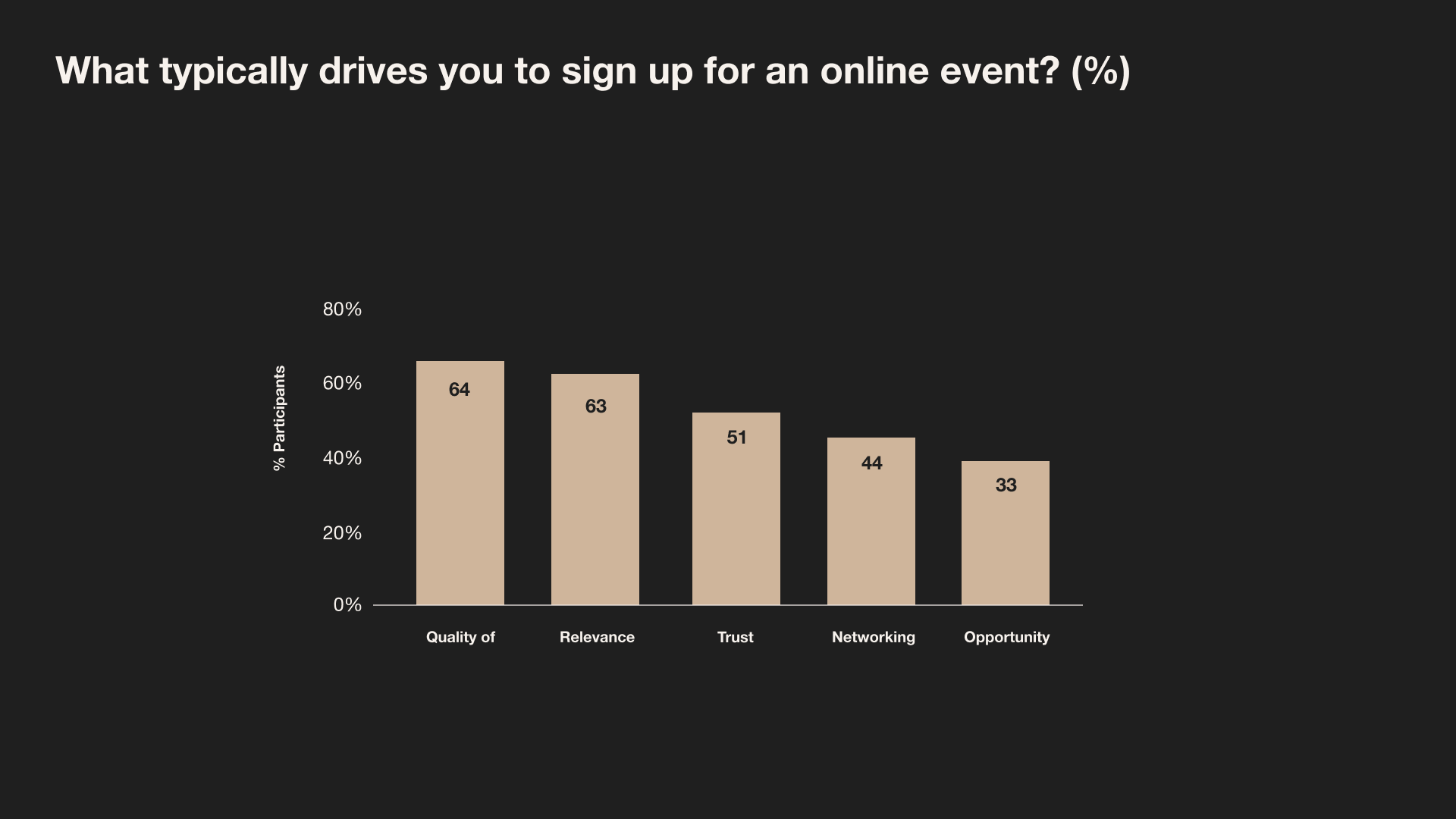
To create high converting webinars, it’s important to focus on the topics and speakers you choose. Read our guide on how to create a webinar for an even more in depth look at what it takes to make an event soar.
Create a stunning experience
There is a lot video content around the web. How can you make sure your content is relevant and exciting for your audience?
Marketers who plan to run effective webinars should not forget the aesthetics of their live content. This includes the quality of the live video stream, branding elements, lower thirds, and the overall design that can help draw in your audience and keep them engaged.
And don’t forget registration! Customize your webinar registration to make sure you capture important information about your audience before the event and make sure the experience makes it simple and easy for folks to sign up.
Build up confidence
It’s only natural to feel jitters before going on the (virtual) stage. In fact many survey respondents said technical challenges (44%), team resources (37%), and content generation (36%) were the main obstacles when producing live events. That’s why it’s so important to use tools and strategies that build people’s confidence rather than tear them down.
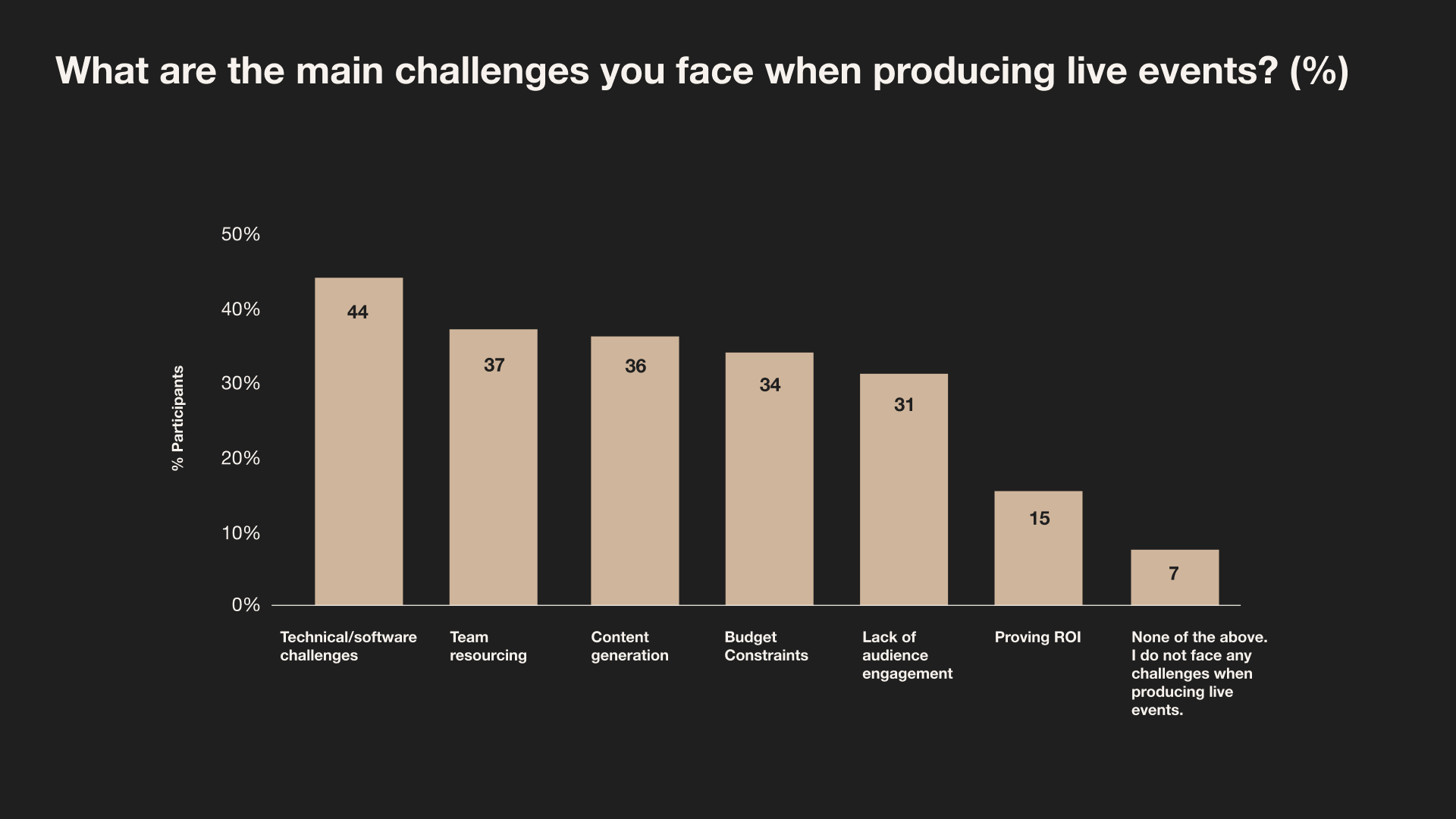
Look for a platform that can mitigate technical hiccups. This can help make it easier to prepare or storyboard webinar content beforehand and rehearse it all with speakers. Bonus points for tools that help your external speakers focus on the most important part of the discussion: sharing their expertise and connecting with the audience.
Engage your audience
The truth is that no one likes to be talked at. Plan to engage audience curiosity by encouraging questions throughout the event, creating fun polls and sharing the results, and building rapport in chat so everyone has a chance to react in real time.
How does a webinar work?
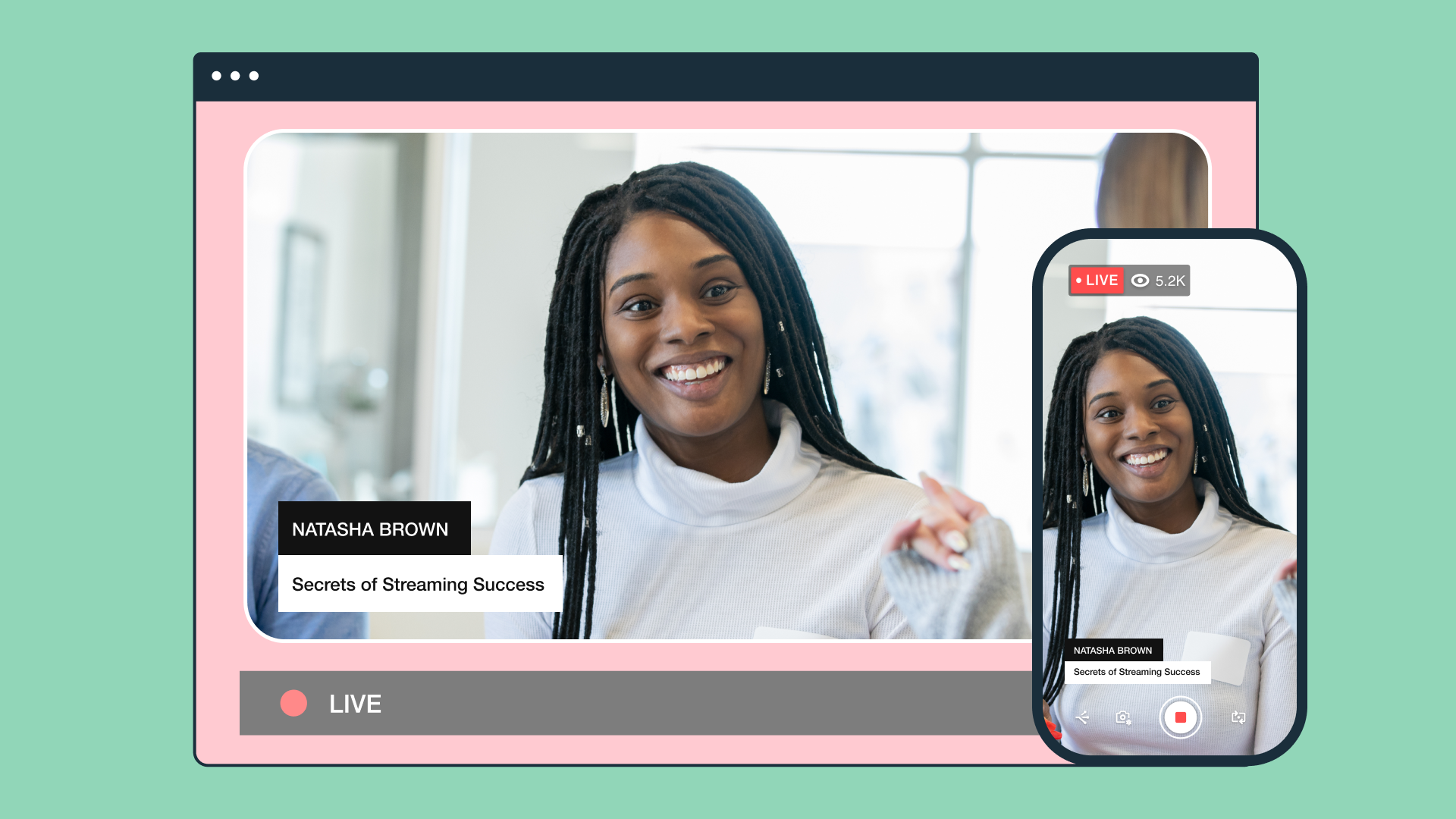
To understand webinars, you have to look at both sides of the coin.
On one side is the audience members (sometimes referred to webinar registrants and webinar attendees). They want to feel engaged. How? By accessing valuable content to level-up their career or solve a problem. They’re sensitive to technology mishaps like audio problems or streaming lag — so you’ll want a way to provide a consistent experience.
On the other side, is the webinar producer or broadcaster. They’re the magicians behind-the-scenes. You’ll find them balancing content creation, production, promotions, and technology to put on a show. They rely on robust video and live streaming tools to wow their audiences.
Now that we understand how webinars work and the goals for both audience members and webinar producers, let’s dive into some common webinar types.
Webinar types
Webinars come in all shapes and sizes. Below, we’ve included four types of webinars you typically use for marketing, internal communications, thought leadership and customer relationships. As you go through the list, consider what type of webinar you’re looking to make.
1. Thought leadership
These webinars are best of breed for commentary on industry trends. Content is data-driven, evidence-based, and moderated by an industry expert or panel of experts. Thought leadership webinars are a strong channel for businesses and independent creators alike.
2. Educational
Educational webinars are deep dives into a particular subject or solution. Case studies, quotes, data, best practices, and other media help audience members immerse themselves in the topic.
3. Training
Training webinars are a great addition to an internal communications strategy. They’re used for employee onboarding or role-based training. They can cover a number of topics like high level business goals, product walkthroughs, and best practices to help employees shine.
4. Customer onboarding
For businesses, customer onboarding is a key part of success. Trainings can include creating user accounts, product demos, feature updates, and best practices.
Live and pre-recorded webinars
No matter what type of webinar you’re hosting, you’ll likely plan to broadcast in one of two ways. Here are a few things to consider when making that decision.
Live webinars are broadcast live with a single speaker guiding the presentation or a moderator supporting several speakers.
The value of a live webinar is that your speakers and audience come together to share in a moment on an important topic. This is a one-shot deal and you’ll likely need lots of prep work upfront.
The value of a live webinar is the real-time engagement from both audience members and speakers.
Pre-recorded webinars are (as the name suggests) recorded and broadcasted later on-demand or simulive. They are generally treated as live experiences where people can watch it at a certain date and time.
A big value-add to pre-recorded webinars is it minimizes the potential for mishaps. Additional takes and editing in post-production result in a high-quality video experience for the audience.
What are the most important webinar features?
No matter the purpose of your webinar, it’s likely you’ll want to be prepared with the features and functions to build the best possible experience.
Here are some of the key features we believe can transform any webinar into a memorable live production.
High quality viewing experience
Let’s face it: people have a lot of options when it comes to viewing content online. Your content and the viewing experience to share it should be key when considering what platform or solution you plan to use. It’s also good to choose a solution that offers viewers the ease of watching the event within their browser, rather than asking them to download an application beforehand.
Powerful broadcaster tools
Webinar hosts need the confidence to go live. Powerful and intuitive broadcaster tools that allow a single user to upload and manipulate content before a live event is a great way to ensure everything is good to go backstage before going live.
Backstage experience
A digital backstage experience that includes private audio and chat can help webinar hosts queue up, coordinate, and manage speakers both before and after they go live. It can also help speakers build rapport behind the scenes or just decompress after the event.
Moderated Q&A and chat
The ability to enable chat or Q&A helps to bring audience members into a live discussion.
Customizable registration page
Webinars are a great method to generate leads for your business. However, a static landing page does little to attract a wide audience or even help you collect the most relevant information before going live. Look for tools that allow for a customizable registration flow with custom fields, branding elements, and ways to connect to your marketing or tech stack.
Email automation
Automated emails take out the additional step of building workflows or campaigns to remind registrants about an upcoming event. Branding your emails can also add a customized touch to the webinar experience.
Branding
Controlling colors, fonts, opacity, and logos all help to build a cohesive virtual experience.
Media playback
Afraid to go live? No problem! Media playback is a way to pre-record content that can be played back live or simulive to help minimize any live mishaps. You can even embed your video on your website to make it easier for your audience to find and watch your content.
Post-event tools
After your event, you can trim your video and add chapters before hosting the content for on-demand use. Want to create a highlight reel? Look for platforms that can create fun GIFs from your content so you can share via email or social campaigns once the event ends.
Analytics
Get a grasp of your webinar performance with macro event stats like total views, average watch time, and peak viewers as well as viewer level analytics like the number of registrants vs attendees, watch time, and any engagement from polls and Q&A. This data can help broadcasters understand viewer behavior at a granular level in order to optimize the experience and help convert viewers into customers.
How to plan a webinar
The best webinars start at the end. What that means is that successful webinar planning starts by working backwards from the go live date and the expected end results.
Here’s our easy-to-follow guide to stay on target when it comes to planing and producing your next webinar.
1. Determine your goals
Goals, goals, goals. It’s all about outcomes! Before you launch your webinar, think about:
- What am I trying to accomplish?
- What content is my target audience looking for?
- Are there specific metrics for success?
2. Identify your target audience
Great content starts with knowing your audience.
If you use personas, start fleshing out your target persona or pulling in existing documentation.
If you’re looking at specific customers, prospects, or target accounts — try listing them out or pull reports to get a visual on who exactly your content needs to resonate with.
3. Plan the topic, title, and format
Once you have your webinar goals and audience locked tight — it’s time to get creative. Brainstorm relevant topics, content, titles, and formats. You may even have some strong opinions of who your speakers will be to help enrich the webinar topic.
4. Kick off your webinar project
Once you’ve gone through all the preliminary goal setting, prep, and creative — it’s time to kick off the campaign.
Webinars can be simple or complex, but almost anyone in the webinar biz will tell you it takes a village. Determine who can support content, creative assets, production, promotions, webinar tech, and reporting so that you can successfully launch an amazing event.
5. Choose and prep your presenters & team
If you’re using external speakers, you’ll need to dedicate time to speaker outreach. Start by tapping into your professional network for speakers. Then branch out to known industry players that can confidently talk about your topic.
Pro tip: Something that webinar pros know is that on-screen chemistry makes a huge impact on both speaker and audience experience.
Once you have your speaker lineup, set up kickoff calls to get them all introduced, build rapport, and help everyone get acclimated as you run up to the big day.
6. Plan out the content, agenda, and presentation flow
Great webinars have some base ingredients. This includes: a charismatic speaker or two, a beautifully designed presentation, and an intuitive flow.
When going live, it’s surprisingly easy to derail a conversation. Make sure to bake in hard deadlines or an agenda to keep everyone on track.
Below, is a sample webinar presentation flow.
Sample presentation flow:
- Welcome and housekeeping notes
- Webinar topic introduction
- Speaker intros
- Core topic discussion
- Live Q&A
- Closing statements
7. Using multimedia to tell a story
You may have heard the writer’s tip to “show don’t tell.” Similarly, a big mistake for webinar producers is not leveraging enough multimedia.
Get creative with pre-roll video and music, interstitials, recordings, and graphs to get your point across. Use text heavy slides sparingly to avoid information overload.
8. Focus on engagement
Your audience shouldn’t spend the duration of a webinar passively taking in content.
Launch polls, add ice breakers, and Q&As throughout the presentation. This helps audience members digest information and clues webinar producers on what areas are most interesting to their audience.
9. Measure success
Webinars are a great tool for collecting data and key insights.
Be sure to check out the number of registrants, attendees, session times, and any audience specific data like Q&A submissions.
There’s a lot of value in identifying conversion sources, too, so be sure to check out if more people converted via social, email, or word of mouth.
10. How long should a webinar be?
Webinars have a sweet spot between 30 minutes to an hour. Anything shorter than 30 minutes might make participants feel like it isn’t worth their time. Anything longer than 60 minutes is too much of an ask. Think of it as a lunch & learn format where folks will pop in to focus for a short, dedicated amount of time.
11. Research and attend other webinars
Webinars are popular. The format is constantly evolving as new technology and techniques are tested in real time. Look at your competitors or other industry heavyweights in your space to spark new ideas.
Webinar tech

It takes a village to pull off a great video production. That includes people, technical resources, and time.
As you prep your next webinar, you’ll likely need some basic know-how of video production and tech. Here are our 7 main points to confidently land the technical execution.
1. Decide on your video platform
The first order of business is identifying where your audience will watch your broadcast. There are plenty of webinar platforms out there, so be sure to research and make an informed decision.
Here are a few things to consider when procuring a solution:
- What quality video can I expect from my webinar technology?
- Where do I need to distribute my video content?
- What interactivity tools are available to my audience?
- What analytics can I capture?
- Have I defined my budget constraints?
2. Understand bandwidth needs
To make a great webinar production, you’ll need to capture quality audio and video. This starts with a solid internet connection.
Our production guru, Tom Gott, strongly recommends a dedicated ethernet connection. This lays the foundation for a solid show. Your upload speed will also be important as it takes bandwidth to push a live streaming video to the platform of your choice.
Bandwidth requirements for webinars
- 1080p stream requires a minimum of 5 Mbps per second, but we recommend doubling that with 10MB per second.
- Additional remote guests will also require at least 2 Mbps per second.
Pro tip: If you’re live streaming from home, plug in from your router, do a speed test, and make sure you have the minimum requirements to stream.
3. Switchers and encoders
The switcher/encoder is how you’ll take the audio and video you’re capturing and package it for delivery to your video platform.
Two options of switchers are:
Livestream Studio: This is a combination, multi camera switcher and video encoder. A switcher/encoder is a great option as it can increase the production level of your show.
Hardware encoders: There are lots of great options for hardware encoders and make it simple to plug your camera, internet, and point it to the platform of your choice.
Keep in mind that most hardware encoders will have a software aspect to them, but that hardware encoders’ software will normally have limitations in terms of functionality.
4. Cameras
What’s great is that high-quality cameras are produced at great, affordable prices.
Cameras can cover a broad spectrum from the phone in your pocket all the way up to traditional broadcast cameras. The sky’s the limit when it comes to camera choices.
For webinars, we recommend going for a mid-level camera that offers a crisp picture to start and then upgrading later on. For more recommendations, check out our essential gear for live streaming.
5. Microphones and audio
Here’s some funny insights from Tom Gott’s Live Streaming Master Class: audience members are likely to forgive bad quality video over poor quality audio.
Even a small investment in your audio can really improve the production quality of your webinar.
Professional microphones include lavaliers or handhelds, but don’t feel overwhelmed! You can find mics and quality live streaming equipment at any budget or price point.
6. Lighting
There are a lot of things you can do with lighting.
Start small. For example, introducing natural light can provide a huge impact on video quality. However, it can be hard to control.
If you’re looking for more control, check out options for light bouncers or reflectors. Also, check out LED lights to create an even light on the webinar speakers.
For more ideas, check out our lighting tips for your next at-home shoot.
7. Bits and bobs
This is basically all the small things when thinking about cameras, encoders, and the internet.
Before you go live, think about whether you need a cable to connect your camera to the encoder, or, if you have multiple devices plugged in, you may need a network switch. If you’re using a laptop, you may need a scan converter to convert video formats.
You can start to build out your own encoder kit with something as simple as an extension cord and power strip.
How to prep your production
Webinar producers are very aware of Murphy’s law. That’s why solid infrastructure in the form of production and contingency planning is an absolute must for webinar pros.
Here are some simple ways you can create solid infrastructure and make sure your speakers and content shine through.
Script planning and practice
As a best practice, we recommend coming to a consensus on your webinar agenda as early as possible. This includes the webinar topic, speakers, cues, and main focus areas. Once you have your agenda locked down, practice as much as you can!
Pro tip: A lot of magic happens at the eleventh hour, but don’t take the risk. For every webinar, plan to have between 3 – 6 weeks of lead time to get all your content ironed out.
Speaker and presenter coaching
Your speakers and presenters are driving the webinar. If they’re excited, your audience is excited. So make sure you’ve dedicated enough time to prep speakers, provide feedback, and coach when needed so they’re ready to take to the stage.
Scheduling prep sessions
A great rule of thumb with practice sessions is scheduling specific prep calls.
We recommend a few different meetings. For a webinar that’s around 45 minutes – 1 hour, here are the three prep sessions you’ll want to slot in before the go live date.
- Dedicated meeting for content and agenda planning (around 60 minutes)
- A tech run through with all speakers and presenters (30 – 45 minutes)
- A dry rehearsal with all speakers present (45 minutes – 1 hour)
Pro tip: Make sure your speakers know up front the amount of time needed to participate for your webinar so that they can commit to all the sessions leading up to your event!
Contingency planning
Going live can be an adrenaline rush for webinar producers, but it can also cause a lot of undue anxiety. Remember that a recovery is always possible if you plan ahead.
If you can, designate a person on your team to manage contingency planning.
This can include:
- Creating a hold slide for any technical difficulties
- Locking in substitute speakers for any speaker change
- Preparing your tech (such as an additional video stream) for potential outages
Good event planning is good contingency planning.Rich Sireno, Vimeo
How to promote your webinar in 7 easy steps
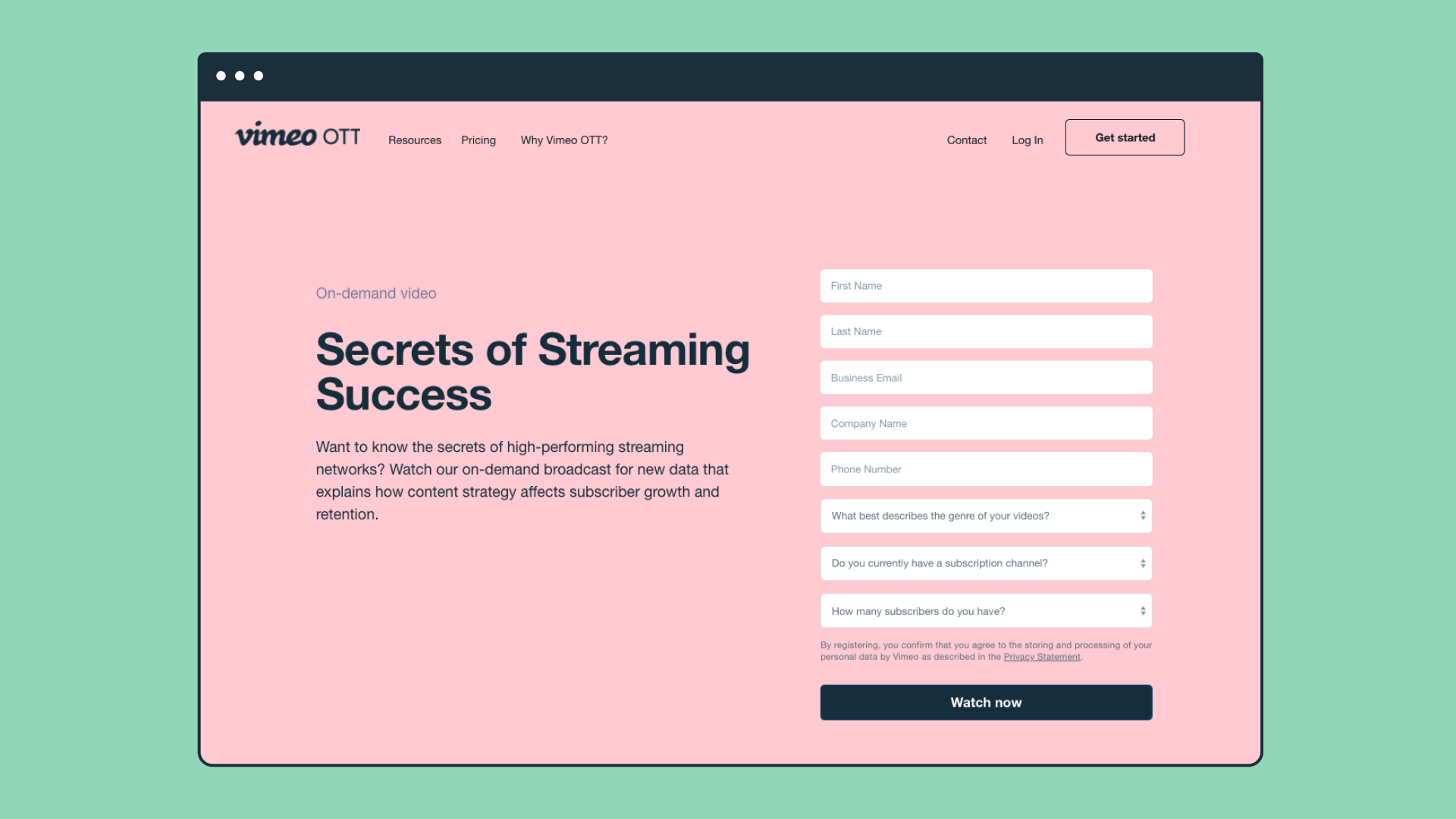
You’ve front loaded all the work of putting on a great production. However no show is complete without an audience. Here are 7 tricks of the trade to make sure your (virtual) house is full.
1. Target the right audience
The best webinars work with the audience in mind. You can use data, personas, customers, or ideal customers to map out the right content that speakers to the right audience.
There are loads of strategies for audience development. Just remember that finding your niche can be a lifelong calibration for some content producers and pro marketers. There’s nothing more fulfilling to a good marketer or creator than reaching their audience where they are.
How do you drive the right audience to your video?
Level up your marketing skills with our latest class on live streaming and audience development.
Level up your marketing skills with our latest class on live streaming and audience development.
2. Build a webinar landing page
Webinar promotions are best done on a designated website page. Create a webinar title, topic, speaker profiles with corresponding photos along with hints on the webinar agenda. Design and artwork can help set the tone of the webinar to get visitors to register.
3. Promote your webinar
Webinar promotions deserve their own dedicated article. But in the interim, focus on dedicated email, social, and video marketing marketing campaigns to help amplify your webinar and reach audiences where the are.
Pro tip: The more lead time you have to promote your webinar the better.
It takes time to drive awareness for an upcoming event. Make sure to build out between 2-4 weeks for a dedicated promotional period to maximize registrations.
4. Send a registration confirmation email
It’s helpful to build this step into your registration flow on your dedicated webinar page. Make sure all pertinent information like webinar title, date, time, and link are available in the confirmation email. Bonus points if you can include a link to calendar invites with the event page link.
5. Automate day-of reminders
If you’ve ever registered for a webinar beforehand, a day-of reminder can be a lifesaver. Folks who register have a set it and forget it mindset, so a little nudge is much appreciated.
6. Don’t forget the post-webinar follow-up
Post-webinar follow-ups are a key part of the experience. Typically, organizations wait 24 hours after the webinar time to send a follow-up. Be sure to include a thank you and link to the on-demand recording if you have one.
7. Invest in an on-demand webinar page
Finally, make all your hard earned work pay off in dividends by repurposing your live webinar into on-demand content. Edit your recording as needed and host the video on a gated page.
This serves two purposes: it helps you collect more data to understand how well your video content performs over time and it helps you generate new webinar leads.
8 tips to drive webinar engagement
A fundamental part of webinar production is delivering a unique and engaging experience. Check out a few ways you can drive engagement for your next webinar.
1. Webinar landing page
Any marketer would say a dedicated landing page for your webinar is a must. It provides all the relevant information about your webinar to help educate potential registrants.
2. Banners, pop ups, ads
To drive registrations, plan to promote your webinar on different marketing channels. Consider banners and pop ups on your website, leverage ads across the web, or add messaging in your content calendar to attract different audiences.
3. Email invitations
At the outreach stage of your webinar, a dedicated email campaign can help you reach your existing database of contacts and drive registrations.
4. Ice breakers
During your webinar, you can break the ice with a fun ice breaker or two.
For thought leadership or educational webinars, these ice breakers can be posed to your speakers and presenters. For more interactive webinars, the ice breaker can also extend to your live audience who can participate via live chat or polls.
5. Live polls
A popular engagement tactic is live polls. They’re great as an ice breaker, gauging experience in the topic, or reaching a consensus with your live audience.
Getting your audience involved through live polls allow webinar producers to get real time feedback while also offering a key opportunity for participation.
6. Live chat
Live chat and live Q&A is a must-have for most webinar experiences. The value is two-fold: audience members can submit questions and comments live while webinar presenters can gauge the level of interest from the audience.
We recommend staffing up your live chat with a minimum of 1-2 moderators to facilitate dialogue and answer questions.
Live chat is great for webinars that have up to 1,000 attendees. For webinars broadcast to thousands of live audience members, it may be less feasible for moderators to actively manage the chat.
7. Live Q&A
Live Q&A is a great way to allow webinar viewers to bring burning questions directly to your on-screen talent. There are a few methods for tackling a live Q&A:
- Upvote Q&A: This method allows viewers to submit and vote on questions they care about most. It allows viewers and presenters to interact with webinar tools.
- Moderated Q&A: Moderated Q&As allow for more curation when handing off questions to speakers/presenters. For internal webinars, this also allows for another layer of security.
- Free form Q&A: As the name suggests, a free form Q&A allows viewers to submit questions and speakers/presenters answer in real time.
8. Closed captioning and accessibility
To drive engagement, make sure your content is accessible to all. Adding closed captions make it possible for those with diverse levels of aural abilities, language comprehension skills, and learning styles to enjoy your content.
Should I create a free or paid webinar?
There are several benefits to both free and paid webinars. Check out some of the benefits for each.
Free webinar
Free webinars are a fantastic option when you’re looking to generate interest in a topic or product. Adding a simple RSVP or registration form can help you collect registrant data for outreach later on.
Additionally, your customers are likely to benefit from free webinar content in the form of tutorials, exclusive content, or product releases. Don’t miss an opportunity to engage existing customers and build a community.
Paid webinar
Paid webinars are a great option for producers whose primarily webinar goals are revenue. Determine the value of your tickets based on your audience, your content, and the overall value your webinar audience will get in return.
Examples of awesome webinars
Great webinars deliver brand equity, topic authority, and credibility. Across industries, creators are building unique video experiences that push the practice to new heights.
Here are a few examples of how you can build your webinars, whether you’re building an experience for internal employees, customers, or newly-minted fans of your brand.
Vimeo Master Classes
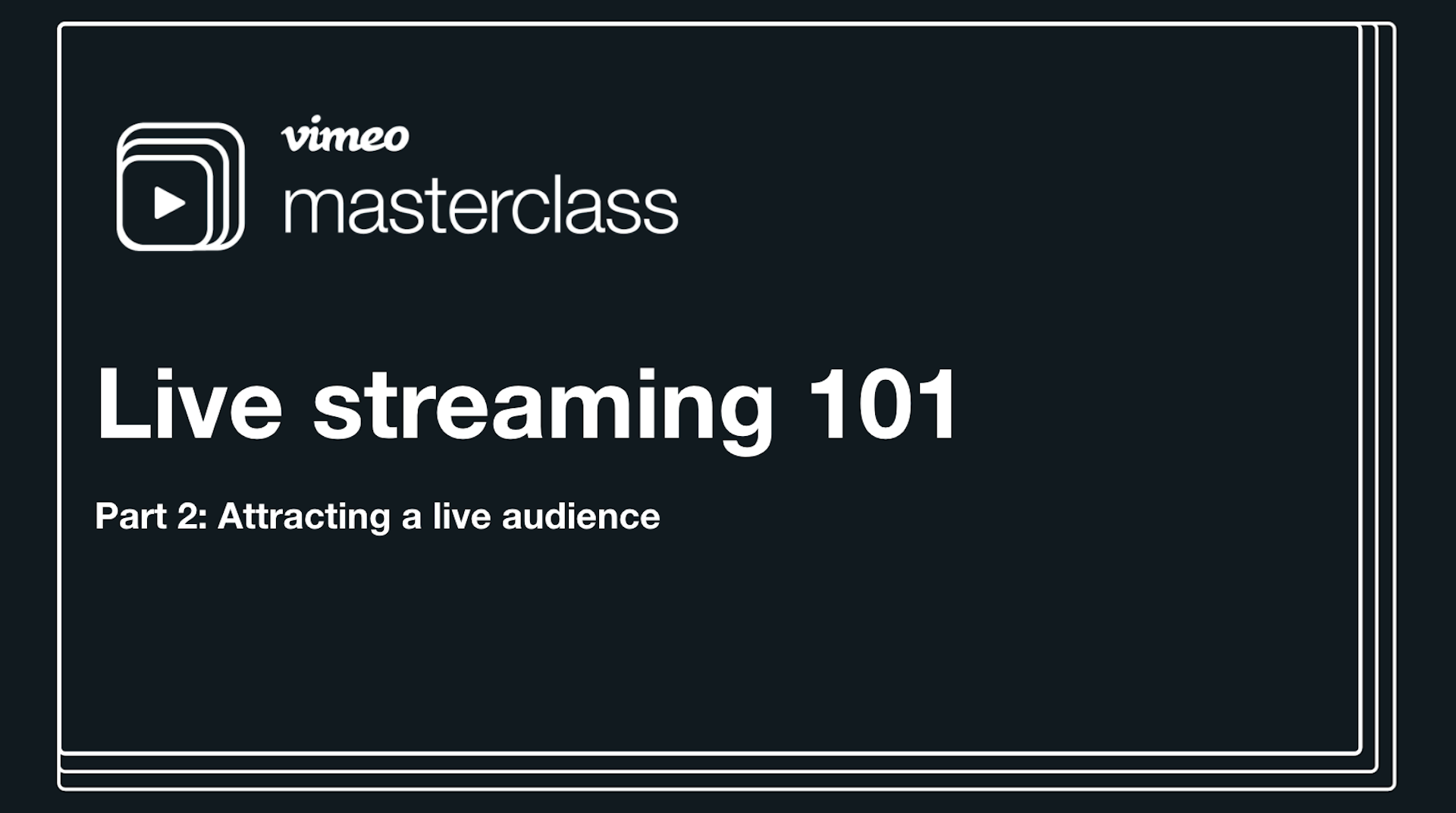
At Vimeo, we provide loads of resources to help new creators launch their first video. The Vimeo Master Class is a series of webinars that cover specific topics from capturing a live stream to growing an audience.
Consider building a curriculum of classes on topics that are valuable to your audience.
Bloomberg Webinars

Bloomberg is a global media company that delivers news, data, and trends to inform businesses around the world. Because of their far reaching audience, Bloomberg invests in creating webinars across topics, languages, and regional markets to deliver pertinent information to viewers and subscribers within their local markets.
No matter how big your brand is, remember to stay local. As you build out a video library, be sure to categorize content in ways that make sense to your audience.
Pro tip: find solutions that will help you host your video content in a single place.
Splash
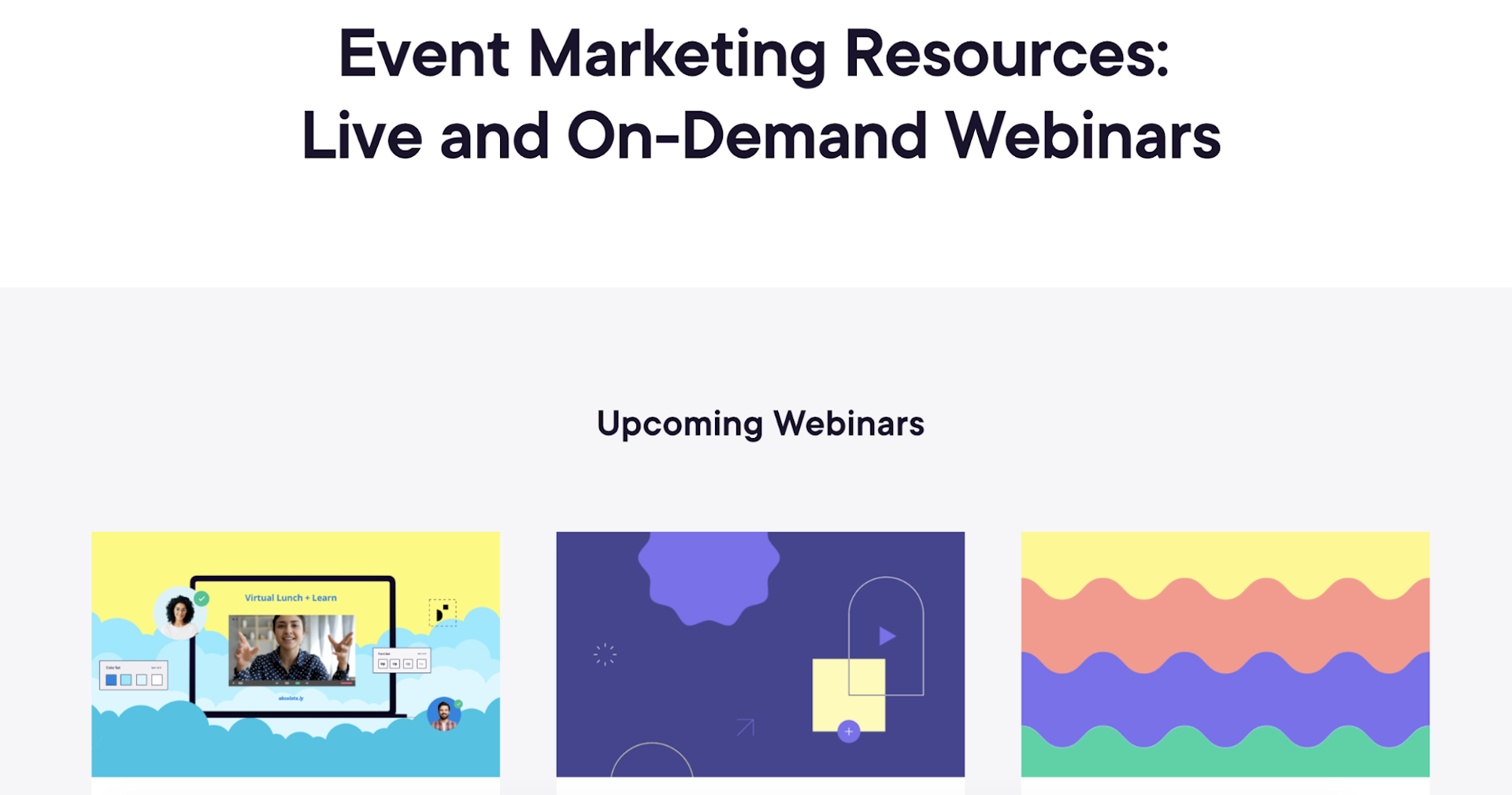
Splash is an event technology platform for brands and businesses. Their library of webinars includes a combination of industry topics and reports, product releases, and how-to content to keep their audience on the pulse of what’s new.
The sky is the limit! Your webinars can cover a lot of ground from product demos, though leadership reports, or fire-side chats.
Smithsonian: ¡Printing the Revolution! The Rise and Impact of Chicano Graphics, 1965 to Now
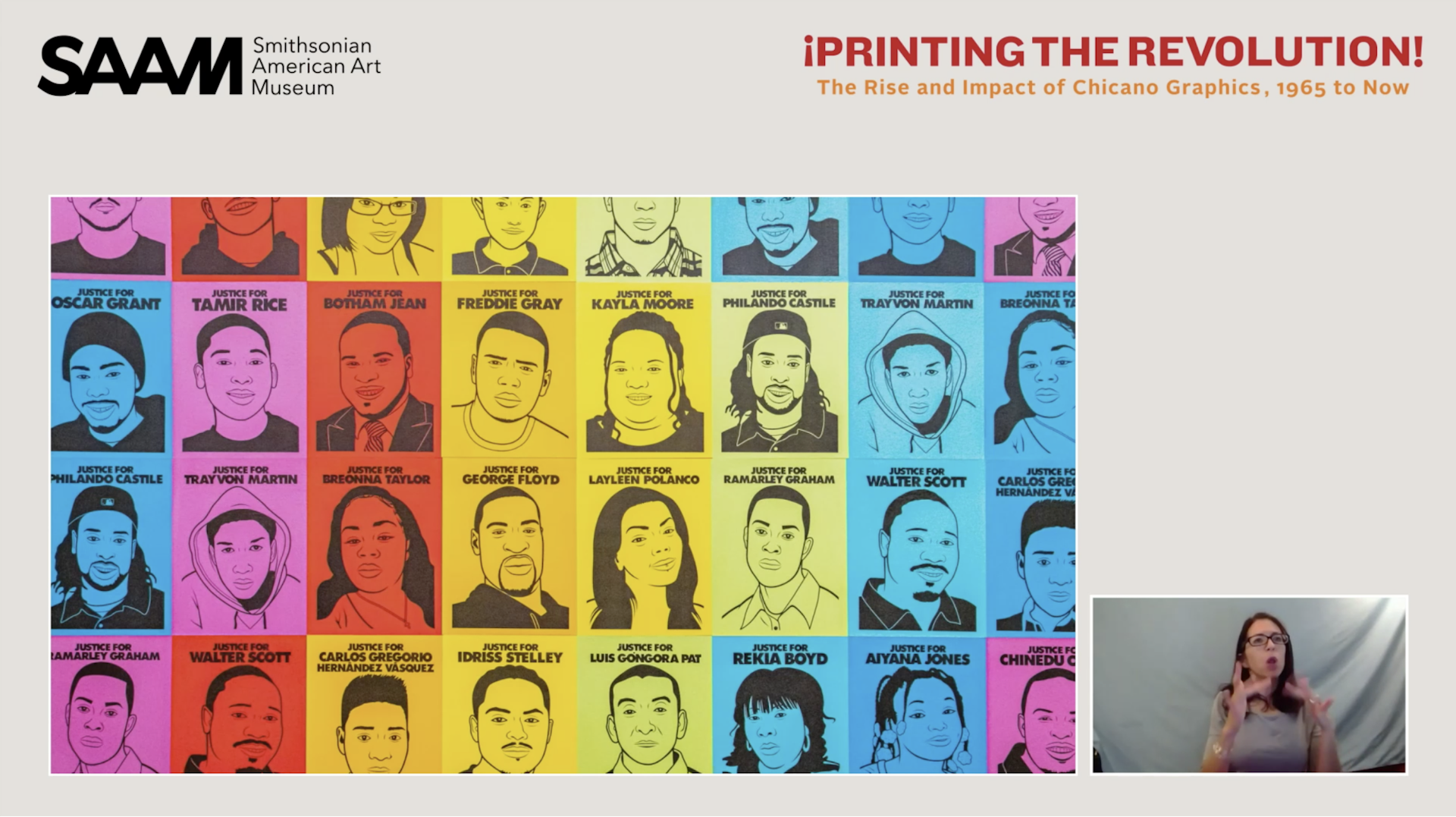
Smithsonian leveraged video to create a virtual exhibition preview of their exhibit ¡Printing the Revolution! The Rise and Impact of Chicano Graphics, 1965 to Now. The program included both live and pre-recorded elements to give viewers a full sense of the exhibit, curation philosophy, and context around each featured artist.
For arts institutions – don’t fret! Consider the ways you can pivot to video to help make your exhibits, performances, and content accessible to all.
Streameo

Vimeo’s streaming event series Streameo launched this spring with massive success. The all-day event included multiple sessions on the future of media, the rise of specialty streaming services, resources on how to fight systemic racism and a spotlight on creators of color, as well as strategies for different OTT (over-the-top) channels.
For an all-day event, weave different sessions with interstitial content, wellness sessions, and other fun content to keep your audience engaged.
Why you should launch a webinar now
If you’re still one the fence about whether or not to launch a webinar — we’ve got you. Check out some of the biggest value-adds to investing in a webinar production.
Share your expertise
Webinars are a great way to share your insights and experience on a specific topic. You can present information or invite other speakers to help elevate your brand’s positioning in a specific topic or industry.
Train your remote team
Remote onboarding and training is a must-have for a distributed workforce. Webinars allow organizations to synchronously or asynchronously train employees on business objectives, role-specific functions, or provide additional updates to keep teams in sync.
Generate sales leads
Webinars are a fantastic way to attract potential customers and generate leads for your sales teams. Use webinars to discuss topics of interest, share product updates, or invite industry leaders to tackle the topics that are most relevant to your audience.
Create evergreen content
Evergreen content is the holy grail for content marketers. Webinars provide value in two ways: first, your lead forms allow you to capture interest in your webinar before it goes live while an on-demand lead form allows you to capture interest post-event. Your content can continue to generate interest and demand long after the show ends.
Build a community
Finally, webinars build community. By creating a recurring series of webinars, you can build an audience that comes back to view your content over a long period of time.
Wrap up
There’s no way around it: great webinars take work. From planning, producing, testing, and generating demand, the entire orchestration can take time. Thankfully, the benefits are worth the investment.
So think big, rally the team, and start planning your next big show.
Discover how to produce your webinar
Originally published on March 9, 2021 and updated on November 3, 2021.

